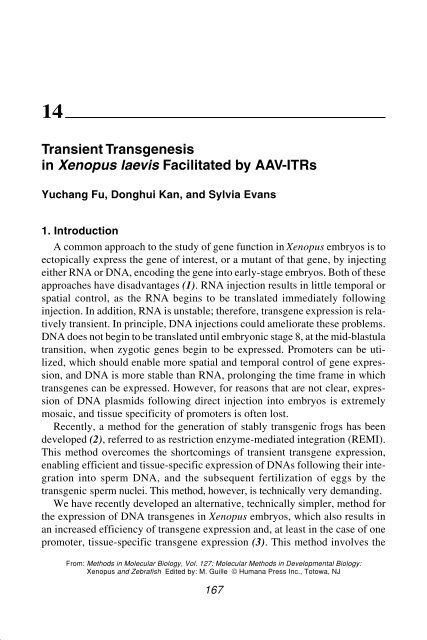Molecular Methods in Developmental Biology Molecular Methods in ...
Molecular Methods in Developmental Biology Molecular Methods in ...
Molecular Methods in Developmental Biology Molecular Methods in ...
- No tags were found...
You also want an ePaper? Increase the reach of your titles
YUMPU automatically turns print PDFs into web optimized ePapers that Google loves.
Transgenesis <strong>in</strong> Xenopus and AAV-ITRs 16714Transient Transgenesis<strong>in</strong> Xenopus laevis Facilitated by AAV-ITRsYuchang Fu, Donghui Kan, and Sylvia Evans1. IntroductionA common approach to the study of gene function <strong>in</strong> Xenopus embryos is toectopically express the gene of <strong>in</strong>terest, or a mutant of that gene, by <strong>in</strong>ject<strong>in</strong>geither RNA or DNA, encod<strong>in</strong>g the gene <strong>in</strong>to early-stage embryos. Both of theseapproaches have disadvantages (1). RNA <strong>in</strong>jection results <strong>in</strong> little temporal orspatial control, as the RNA beg<strong>in</strong>s to be translated immediately follow<strong>in</strong>g<strong>in</strong>jection. In addition, RNA is unstable; therefore, transgene expression is relativelytransient. In pr<strong>in</strong>ciple, DNA <strong>in</strong>jections could ameliorate these problems.DNA does not beg<strong>in</strong> to be translated until embryonic stage 8, at the mid-blastulatransition, when zygotic genes beg<strong>in</strong> to be expressed. Promoters can be utilized,which should enable more spatial and temporal control of gene expression,and DNA is more stable than RNA, prolong<strong>in</strong>g the time frame <strong>in</strong> whichtransgenes can be expressed. However, for reasons that are not clear, expressionof DNA plasmids follow<strong>in</strong>g direct <strong>in</strong>jection <strong>in</strong>to embryos is extremelymosaic, and tissue specificity of promoters is often lost.Recently, a method for the generation of stably transgenic frogs has beendeveloped (2), referred to as restriction enzyme-mediated <strong>in</strong>tegration (REMI).This method overcomes the shortcom<strong>in</strong>gs of transient transgene expression,enabl<strong>in</strong>g efficient and tissue-specific expression of DNAs follow<strong>in</strong>g their <strong>in</strong>tegration<strong>in</strong>to sperm DNA, and the subsequent fertilization of eggs by thetransgenic sperm nuclei. This method, however, is technically very demand<strong>in</strong>g.We have recently developed an alternative, technically simpler, method forthe expression of DNA transgenes <strong>in</strong> Xenopus embryos, which also results <strong>in</strong>an <strong>in</strong>creased efficiency of transgene expression and, at least <strong>in</strong> the case of onepromoter, tissue-specific transgene expression (3). This method <strong>in</strong>volves theFrom: <strong>Methods</strong> <strong>in</strong> <strong>Molecular</strong> <strong>Biology</strong>, Vol. 127: <strong>Molecular</strong> <strong>Methods</strong> <strong>in</strong> <strong>Developmental</strong> <strong>Biology</strong>:Xenopus and Zebrafish Edited by: M. Guille © Humana Press Inc., Totowa, NJ167












